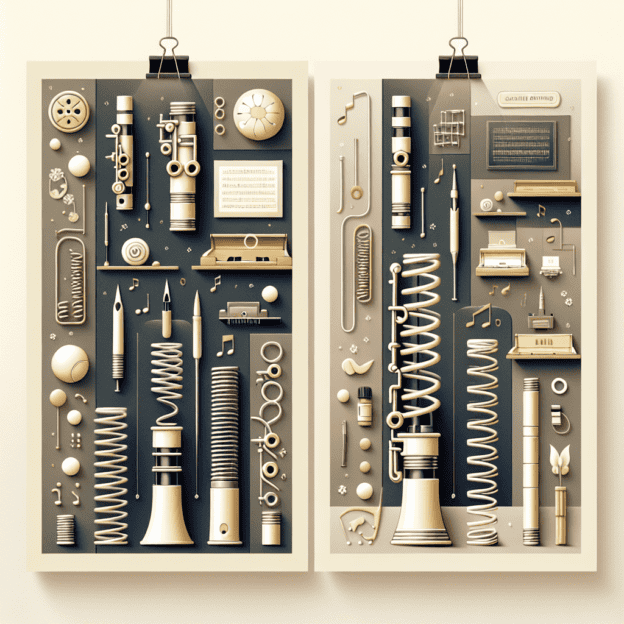When people think of clarinets, they often picture the elegant sound, the powerful keys, and yes, perhaps even the reeds—but how often does anyone actually talk about springs? Those unsung heroes behind every smooth, responsive key action deserve a bit of attention, don't you think? Let's explore the world of clarinet spring types and materials to see what makes them work—and maybe, what makes you connect with (or struggle against) your instrument!
Springs on clarinets come in two main forms: flat springs and needle springs (often called wire springs). Now, before we get too technical, here's the gist: these small yet mighty components help the keys return to their resting position with the right tension. Whether you're playing fiery staccatos or buttery legatos, springs play a key role. But not all springs are created equal—far from it! Their materials, shapes, and overall designs can significantly affect performance and even maintenance routines. They might be small, but boy, do they pack a punch.
| Spring Type | Pros | Cons |
|---|---|---|
| Flat Springs | Durable, long-lasting tension | Require precise adjustment, can rust |
| Needle Springs | Flexible, lightweight, moisture-resistant | May need more frequent replacement |
Flat Springs: The Traditional Choice
Flat springs have been a staple in clarinet design for, well, forever. Made of tempered metal, usually steel or sometimes brass, flat springs are durable, but they do require precise adjustment to keep them from over- or under-tensioning. If you're an older clarinet owner or even a collector, you might notice that flat springs are often used in vintage models—certainly a nod to their longevity. Martin Freres Clarinets made progress with their flat spring systems in the early days, fine-tuning them to work seamlessly with different key mechanisms.
Here's the thing about flat springs: they're strong but can be a bit finicky. Because they're, well, flat, they press up against the key levers in a way that doesn't always work harmoniously with modern designs. But don't write them off if you spot them in your ‘old reliable.' When adjusted properly, they hold their tension longer than you'd expect, offering a sturdy feel under your fingers that some players actually prefer. Watch out; they can sometimes rust if exposed to moisture for too long!
Needle Springs: Sleeker and More Modern
Needle springs, also known as wire springs, basically look like little springs plucked off a sewing machine. Modern clarinets often use these due to their flexibility and lighter weight—perfect for faster, more agile passagework. These springs are usually made of blue steel or stainless steel, with the former offering unmatched elasticity. If you've ever played a Martin Freres Clarinet with needle springs, you'd know how pleasingly responsive the keys feel.
While needle springs are flexible and adjust easily, they sometimes need replacing more often than their flat counterparts. Regular players—especially those who love high-energy performances—tend to give their needle springs a real workout. Adjustments might also need to be done every now and then to keep the action feeling consistent. However, one big bonus is that they handle moisture much better; no rust here! For younger students or casual players, a clarinet with needle springs might be a safer bet since it doesn't require as much upkeep to maintain its playability.
Materials Matter: From Blue Steel to Bronze
If we're talking materials (and let's be honest, we have to), clarinet springs aren't as uniform as you may think. Believe it or not, the pros and cons of each material go beyond just cost or availability. Here's your quick guide:
- Blue Steel: Known for elasticity, strength, and overall nimbleness. This is the premium pick for needle springs and loved by professionals for its long-lasting durability.
- Brass: You'll find brass in beginner models or older clarinets—it's softer, easier to manipulate, and isn't prone to rust. However, they can warp more easily.
- Stainless Steel: Moisture-resistant and tough as nails, stainless steel tends to last a long time while requiring minimal adjustments. Great for all-season players!
- Phosphor Bronze: Less common but intriguing nonetheless, this material adds a smoother action while being naturally resistant to corrosion. Plus, it looks classy (not that anyone really sees your springs).
And if you're thinking, “Well, which should my clarinet use?”—I'd say it depends on your style. Are you a busy performer looking for something versatile, like blue steel? Or do you casually play for enjoyment with the reassuring feel of stainless steel? It's all about finding the right match.
Maintenance Matters: Caring for Your Springs
Speaking of matches, clarinets sound their best when keys move smoothly, and that requires regular maintenance. However, caring for springs isn't as challenging as it sounds. Start by keeping the inside of your clarinet dry post-practice; a bit of moisture can cause spring tension to weaken over time (especially in brass springs). A swab or cloth works wonders here
For adjustments, take your instrument to a professional if you notice any sticking keys or sluggishness. While adjusting wire springs might seem like an easy DIY, it's trickier than it looks! Also, don't forget to keep an eye on unusual wear or tear on the spring fittings. Instruments like those from Martin Freres tend to use high-quality fittings that stay reliable for the long haul, but it's still a good habit to give your clarinet a routine checkup.
Which Spring Type Suits You?
This is one of those debates you'll hear buzzing around clarinetists: flat vs. needle, steel vs. brass. The answer? It's personal! Each clarinet player has a unique touch and feel, and choosing the right spring type is ultimately about balance. Beginners might prefer something low-maintenance, while seasoned players will know how to tweak and care for their more specialized setups. It's not a “better or worse,” but rather an idea of what best complements your skill set and musical goals.
One thing's clear, though—understanding your clarinet springs is no minor issue! These small mechanisms can mean the difference between hitting notes with confidence or fumbling awkwardly during a piece. So the next time you're playing an opening run or gripping that clarinet during a solo, think of those humble springs. They may not get the spotlight, but without them, there'd be no show at all.







